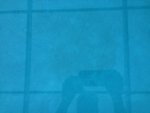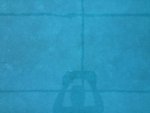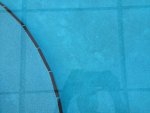Hello again Henry!
So please forgive me in that some of the following advice may sound like its from the pool store - oh, the irony

Let's not mess with the stains until you've identified them...no AA for you, I'm afraid

AA can turn a copper stain brown-blackish on the odd occasion and that may be what as happened to you (other times it will lift it.) I don't want you to darken all the stains.
Next experiment...if you have some dry acid, put that in a sock and hold to a stain area. See if it lightens the stain.
If it does, an acid wash may be the best remedy, or spot treatment depending on the scope of stains. You could try a "wet" acid wash if you didnt want to go the full route as the tech had suggested to you. Can you post a picture?
If the dry acid works and you'd rather not acid wash your new surface (I don't know. Lot about plaster but imagine this shortens its life) you might try this tool for removing spot stain areas with MA
Amazon.com : Purity Pool OS Out Spot Stain Remover : Swimming Pool Stain Removers : Patio, Lawn Garden
Another approach AS YOUVE ALREADY HEARD

to more positively identifying stains would be to use Jack's Magic Stain ID kit:
Amazon.com: JACK Garden
Which brings you BACK to the beginning of your thread: if your salt is 3500 and your TDS is 4500 the MY take is your TDS is only 1000 fir example and jack's stain I'd kit should work. But please talk to jacks to confirm!
Depending on the result, you could then treat with the associated Jack's stain removal product. Javk's Magic metal sequestrants are one of the recommended brands here at TFP. The other is Metal Magic. Jack's is mfg in Florida, as I recall, and they do have a help line to discuss problematic stains, so that might be a route to go. (Actually, Metal Magic has a great guy too at proteam, so really, either will give you phone support if needed...but Jack's may be more useful to you due to the brownish results because the have the stain ID kit.)
Re: FC level...can you try to dilute a sample with 50% bottled or tap water get a ballpark read? What percentage had your T15 been running prior to shutting it off? How long do you run your filter each day?
I'm glad you now have a kit that you can read true and higher FC because it will ultimately help you manage your water...SO why not try to get a full reading...because you're going to need to figure out how it got that high to dial in a better balance...AND you'll need to do this to effectively treat or manage staining and metal testing.
You can lower FC if desired with sodium thiosulphate (eg:
Amazon.com : In The Swim Pool Water Chlorine Neutralizer - 2.25 lbs. : Sodium Thiosulfate : Patio, Lawn Garden)
Let us know your results in each case and maybe we can sleuth out the cause/effect here.
Also...do you have a heater, and if so, does it have a bypass?
Lastly, can you recall your average ph reading throughout the summer? Keeping ph lower (eg. 7.2) is better if you do have metals, and uncontrolled high PH is what can precipitate staining.
Since you just did a plaster job though, I'd like to try to find one of the TFPers who is a plaster expert to see if he has more authoritative advice or if he thinks you need to further contact the folks who did your diamond bright...I'll see if I can dig up his name to review.
There are some "tough" staining combos that happen, such as iron phosphate scale etc. that don't always behave or respond to normal identification and treatment routes. But lets first see if dry acid and/or stain ID kit can shed any light.
Cheers!




